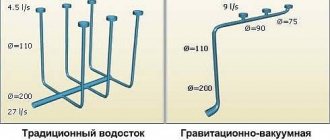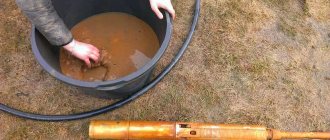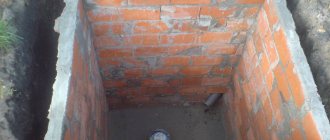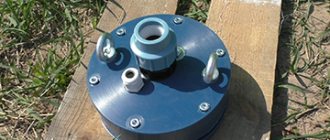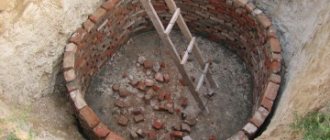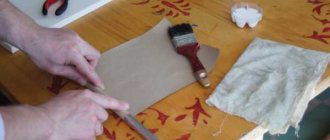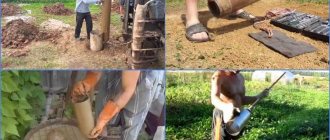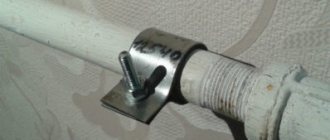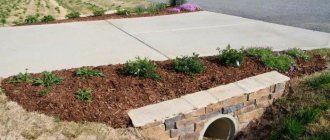For individual water supply to private houses, water intake is most often used from wells and boreholes, the quality of water in which is determined by the depth and structure of the aquifer. In common sand wells, it is necessary to have filter elements at the end of the casing, which are supplied and manufactured at the factory. But in some cases, it is more practical to make a filter for a well with your own hands, most suitable for a specific water intake source and in no way inferior to factory samples.
To do this, it is necessary to study existing methods of filtering well water and build your own system based on them. Carrying out this work does not require expensive special tools and can be done with your own hands without a lot of time if you have the appropriate components and knowledge of the technology.
Fig. 1 Types of filter casing pipes
What is a well filter and its structure
Water purification from a well occurs in two stages - with a well filter and surface filtration systems built into the water main. In this case, the well filter has a structure consisting of three main elements:
- Above-filter area. The part that plays the role of fittings when mounted on a column.
- Filter elements. Includes the holes in the pipe of the correct size and the external materials that are attached to it.
- Sump. The space for placing soil particles trapped inside the source or screened out by filter elements is the lower part of the filter without perforation. The sump for water from the well is about 0.5 m long.
Rice. 2 Filter design
Methods for purifying water in a cottage
When choosing a system and equipment for water treatment in a country house, you should adhere to the following algorithm: first, a laboratory analysis of the water is carried out, then substances and compounds are identified, the content of which exceeds the maximum permissible standards, then a water treatment system is selected and designed, then the equipment is installed on site, then - The operation of the equipment is checked and it is put into operation.
In fact, each of the above points may have sub-points. First you need to understand what equipment, how and what purifies water. For example, household filters do the following:
- “Mechanics” are cleaned with mechanical filters.
- “Chemistry” is cleaned using chemical and physical-chemical methods, namely: inorganics are cleaned mainly by ion exchange, organics – mainly by sorption.
- “Biology” is cleaned with special techniques: active silver added to sorbents gets rid of bacteria; Only membranes (reverse osmosis, nanofiltration) and other high-tech methods, for example, ultraviolet irradiation of water, will get rid of viruses.
Alexander Pimenov
The reverse osmosis membrane is universal and takes on the work of all the methods described above. This purification method is suitable for all types of water - soft, hard, super-hard, ferrous.
With reverse osmosis, the pores of the membrane allow only water and oxygen molecules to pass through. Although substances with a molecular size smaller than H2O also pass through them, there are usually few of them.
Important: when installing a reverse osmosis system, one of the key elements of the system is the mineralizer. It contains natural components that restore the mineral composition of water that has passed through the reverse osmosis membrane.
Why do you need a well filter?
The need for filtration inside the well is caused by the following circumstances:
- Purified well water, unlike contaminated water, increases the service life of submersible and surface pumps for a well - impellers, membranes and other moving components wear out less.
- Filtered water, when further passing through the pipeline, pollutes less filters in water purification systems located in the water supply system - this allows you to save money on the purchase of new cartridges and increases their durability.
- Filtration increases the service life of automatic control systems for pumping equipment - pressure and idle speed switches, hydraulic accumulator.
- Purified water contributes to better permeability of the water main and increases the service life of plumbing units (check valves, ball valves, mixers).
- Additional well treatment contributes to better quality of drinking water used in households.
Rice. 3 Filter element design
Calculation of the performance of the treatment complex
Once the water composition has been determined, the capacity of the future treatment plant is calculated. Competent engineering calculations will provide the house with the necessary volume of water. Water consumption depends on the number of residents and the number of water intake points in the water supply. At these points there are usually washing machines, faucets, showers and other useful household appliances. The presence of swimming pools, baths and other consumers is also taken into account.
Even with the necessary information on hand, it is difficult to calculate water consumption without professional knowledge. We need special formulas, tables, diagrams. The engineering department of our company designs and assembles cleaning systems individually for each home. We use special programs for calculating water consumption. We calculate the required pressure, take into account the resistance of filter materials and other parameters in order to provide your home with enough water for a comfortable life.
Materials for filtration equipment
The efficiency of cleaning depends on the quality of the filtration material; a limited number of them are used in wells, the main ones being:
- Stainless steel. In addition to strength, the material has flexibility and excellent corrosion resistance; the durability of stainless steel is tens of years. It is used to make strong meshes and wires that are mounted on top of the pipes. The disadvantages include the high cost of stainless steel products.
- Plastic. Plastic is another common material for the manufacture of filters in water sources; meshes and cords are made from it, which are cheaper than stainless steel. Plastic is corrosion-resistant and inert to most chemicals, easy to install and has a long service life. The disadvantages of plastics include low physical strength, which does not allow them to withstand heavy loads at significant depths.
- Non-ferrous metals. Copper, brass, and bronze can be used in the manufacture of water filters without any restrictions; they have high corrosion resistance and a long service life. Soft alloys with a high copper content are recommended for use at shallow depths to avoid deformation from strong water pressure. In the manufacture of filter elements, brass mesh and thick wire made of brass or copper are used.
Rice. 4 Filter for casing pipe - installation in the well
- Steel. Steel filters are susceptible to corrosion and can be used as a budget option in water intake sources intended for technical needs. Increased content of iron oxide in water as a result of iron corrosion of more than 0.3 mg. per liter leaves a yellow residue on water main equipment and plumbing fixtures. Galvanized steel also rusts over time to form zinc oxides, which are harmful to human health - this material is not recommended for use in water filter elements.
Principle of operation
A slotted filter for a well is a stainless steel or polypropylene pipe with longitudinal slots . It has a housing with inlet and outlet pipes and a plate filter element.
In the simplest models of such a filter, a metal mesh is used as a plate element. The upper and lower slot filters, as well as the water pipe, together form the distribution system of the filter device.
Special holes 15-25 mm wide prevent the smallest particles from leaving the filter, supplying clean water without impurities.
Reference. The slot filter is installed in wells where rocks prone to collapse are found, as well as on rocky soils.
Types of filters and their features
Well filters can be divided into two large groups:
- simple - with various types of holes in the bottom casing pipes;
- complex - they are a separate structure placed at the location of the bottom pipe or with filter elements mounted on the casing pipe.
In simple devices, round or slot-like holes are cut in the pipe surface; in more complex designs, wire is wound in dense rows or a fine mesh is fixed.
Installation
Installation procedure.
- Before lowering the filter into the well, you need to check the depth of the wellbore. If it does not decrease, then you can start lowering the pipes with the filter. They must be equal to the length of the well itself.
- In the event of a collapse of the shaft walls, clean the bottom with a bailer and then install a filter.
- When installing the structure, the casing pipe is lifted until the filter is exposed.
- After this, you need to release the production string to the bottom and hang out the casing.
Do-it-yourself well filter - how to make it
Well filters are installed on the bottom pipe and lowered into the source along with the casing; making them yourself is pointless if you are not involved in downhole drilling. The problem is relevant for drilling organizations and individual drillers who want to make an inexpensive, high-quality filter with high characteristics and parameters that are most suitable for a specific well (depth, soil composition).
Gravel
To install a gravel filter with your own hands, proceed as follows:
- First, the size of the gravel backfill is selected taking into account the granulometric composition of the aquifer sand. To do this, contaminated water is removed to the surface, and after it is filtered, the size of the sand particles is determined.
- The gravel fill should have a granule size approximately 8 times the minimum diameter of the sand particles or 5 times their maximum diameter. For example, if the dimensional parameters of aquifer sand are 0.5 - 1 mm, the backfill should have dimensions of 4 - 5 mm, with sand grains 0.25 - 0.5 mm. gravel sizes are 2 - 2.5 mm.
- The gravel fraction selected by size is immersed in the well bottom using the free-fall method in a water flow; its minimum thickness is 50 mm.
- Multi-layer backfilling is allowed, starting with larger fractions and moving on to small particles.
Rice. 11 Sprinkling the casing
Hole filter for perforated well
You can make a perforated filter yourself without much effort if you have a simple tool (a drill with a suitable drill bit). When installing a perforated filter from 125 HDPE casing pipe, proceed as follows:
- Markings are made, noting the distance from the bottom plug to the end of the sump about 50 cm, the length of the filter part with perforation is 110 cm.
- Draw 4 equally spaced lines along the pipe, drill 4 rows of holes with a diameter of 20 - 22 mm. with a feather drill for wood - they need to be done in a checkerboard pattern. The distance between them should be about 10 cm.
- The burrs formed during the drilling process are cleaned with sandpaper, or they can be scorched with a gas torch.
If the depth of the source is small, the number of holes can be increased to 8 rows, and also holes can be made for almost the entire length of a 3-meter pipe, their number will be about 20 - 25 pieces in a row.
Rice. 12 DIY holey filter
Slotted
The manufacture of a slot filter is rarely carried out independently - the process is labor-intensive and time-consuming. When installing it, proceed as follows:
- Make markings along the pipe surface, dividing it into 8 equal-sized sectors, drawing 8 lines and retreating 50 cm from the ends.
- To cut slots, take a grinder with a disc for metal or concrete, but it should be taken into account that the slots from the disc for metal will have a smaller width.
- Cutting is done in increments of 10 mm. by the width of the sector between two lines, alternating free longitudinal sections with cut ones. In this case, stiffening ribs 20 mm wide are left between the slots. after 10 - 20 lines.
- After cutting out 4 longitudinal segments with slotted areas, their surface is cleaned of burrs with sandpaper.
Rice. 13 Plastic pipe with slots
Manufacturing of Wire Filter System
Such designs are characterized by increased strength, and compared to previous options they also have a longer service life. They are designed quite simply: a perforated pipe, a wire winding and a protective mesh. To create a wire filter, perform the following sequence of operations:
- make a primary slot filter;
- Solder the longitudinal stiffeners. For this purpose, use stainless steel rods with a diameter of 5 millimeters;
- wrap the resulting base with stainless steel wire with a cross-section of 2.5 millimeters.
It would seem that everything is quite simple. However, technology violations, such as errors in winding or weak soldering, will cause malfunctions. Therefore, it is recommended to buy a wire nozzle ready-made. It is not difficult to connect it with the main one.
Disinfection
An important step to ensure that water meets regulatory requirements. To remove bacteria and unwanted microorganisms, the following are used:
- Blocks filled with sorbents of various types. Products containing coal have become widespread in everyday life. Thanks to its use, the filter improves the organoleptic properties of water.
- Ultraviolet. The device consists of a steel case with a quartz case and an ultraviolet lamp located inside. Passing through the device, water is irradiated by an ultraviolet stream and is thereby disinfected. The radiation dose depends on the level of contamination of water by microbiological organisms. The device allows vertical and horizontal placement.
- Chlorination, fluoridation. The method can be called traditional. The resulting suspension is subsequently removed. It is practically not used in private home water supply systems.
Video description
Reverse osmosis fights not only impurities, but also odors, as the following video confirms:
Systems are usually installed directly under the sink. A separate tap is used to supply drinking water. Replacement of the membrane and backfill must be carried out at specified intervals.
Purified water is close to distilledSource thewalls.ru
